Days 153-154 & 166-170: Mandalay & General Myanmar
We weren’t sure what to expect from Myanmar. We hadn’t heard much about it since they do a good job of keeping journalists out of the country. What we found will take a few blog entries to convey. Since we’re pretty sure that many of our readers are equally unfamiliar with the country, we’re going to be a bit liberal with descriptions and pictures of this beautiful country full of friendly people.
Mandalay is a good-sized city in the center of northern Myanmar and the region is home to many past capitols of the country. Our first cultural experience in Myanmar was using the bathroom at the airport. Overly helpful attendants usher you into a stall and await your emergence before starting the sink faucet and putting soap directly into your hands. The toilet paper here is virtually identical to party streamers and some of it is a festive purple to add a bit of panache to an otherwise unfestive activity.
On the ride from the airport we were introduced to an oddity of road rules. In Myanmar people drive on the right-hand side of the road, but the steering wheel is also on the right. [We had read that an astrologer told a high ranking official to move the country to the right; the official took this literally.] This makes passing large trucks on the one-lane roads pretty exciting. Lots of horn use lets people know that you’re coming and they do an excellent job of getting out of the way. Of course the largest vehicle gets priority. On most of the roads into and out of a town or village, some “officials” have set up road blocks to collect a “road tax” from every vehicle passing through. There are also frequent military or police checkpoints where you have to show ID or passport and they record all of the information (names, country, and passport and visa numbers).
The currency in Myanmar is called ‘kyat’ and is pronounced like “chat”. There are about 1100 kyat per dollar and changing $100 into kyat leaves your pockets overflowing with over a hundred of the large 1000 kyat notes. Inflation in Myanmar runs at something like 30% annually, which means that prices in kyat increase very quickly. Fortunately, the secondary (or perhaps primary) currency in the country is the US dollar. This kept our pockets from exploding from the pressure of too much kyat.
The food in Myanmar is fantastic! Bamar cuisine is somewhere between Chinese and Thai. But there are many excellent Indian and Nepali restaurants in the country that serve up some of the best food we’ve had on the trip. A great discovery we made is the Burmese teashop. Here they serve terrific sweet milky tea along with an assortment of snacks. Depending on whether the shop is Indian or Chinese influenced, there might be samosas and chapati, or ki kyar kwe (long donuts) or shredded coconut filled puff balls. No matter how much we ordered, our highest teashop bill was less than $0.70. The teashops are serviced by an army of kids in the same outfit who bring you whatever you want. To get their attention, you make a loud kiss-kiss sound and one of them will come running. We couldn’t actually bring ourselves to make this sound to young kids. [So next time your loved one sends you a loud kiss, they might just be asking for more tea.]
Preschool-sized stools come standard at teashops.
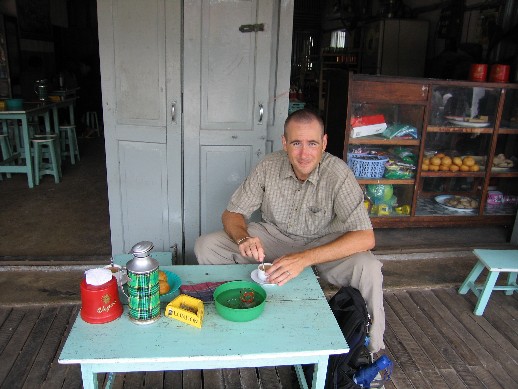
The resourceful Burmese manufacture a bunch of mainstream soda knock-offs with very similar labels and flavors to the Big Boys but actually taste better (and cost about $0.10 per bottle). Our favorites were ‘Lemon Sparkling’ and ‘Crusher’ orange. There are a good half-dozen locally-brewed beers in Myanmar with Mandalay Draft being Marcus’ favorite.
Transport in Myanmar is interesting. Apart from long-distance buses, there are two-bench trucks that run set routes, but you have to know the Burmese numbers to know which bus to get on. More common are ‘trishaws’ which are human-powered bicycles with two back-to-back seats for passengers. These cost tourists about $0.10 per km, which sounds like painfully little to have someone pedal you around, but at least you’re putting money directly into the hands of the local population. In addition to normal taxis, there are microscopic blue trucks which – apart from looking like a clown-mobile at the circus – have room for about four very cramped people in the back.
Stated simply, the people in Myanmar look like a million kyat! The guys all wear a plaid ‘longyi’ (a long, wrap-around akin to a sarong) with a button-down shirt. And the women wear elegant longyis and form-fitting blouses with gold threads. Everyone looks great! Most people have what looks like white paste smeared on their faces. We thought it was a local kind of make-up at first, but found out it is a natural sunblock. Most of the locals get around town on bicycles which looks difficult to do while wearing a skirt. This probably explains why most of the bikes would be considered women’s-style in the states. This is the first country we’ve been to that more people are wearing local styles instead of Wrangler knock-offs and logo t-shirts.
The media in Myanmar is goverment controlled and the locally-produced channels (MRTV3 & 4) show lots of quality propaganda. The generals get a whole lot of face time going all over the country making sure things are up to snuff. They also show lots of military parades and exercises complete with patriotic sounding music. Below is a shot of some tanks cruising around the country on TV.
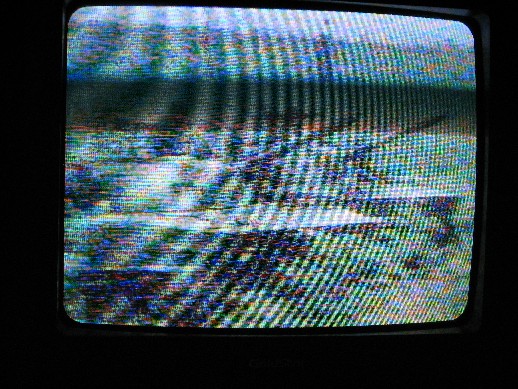
We hadn’t seen any TV in a while so it was surprising to find BBC World News or CNN shown at almost every hotel. We wouldn’t have thought the generals would like people to know what all is going on in the world, but nobody seemed to be cagey about showing western news. We spent a good amount of time watching the news to catch up on the world and follow the (long overdue) Israeli withdrawl from Gaza and soaring oil prices.
Mandalay is dominated by Mandalay Fort, which is a huge walled enclosure in the middle of the city surrounded by a moat. It used to house the royal palace but now houses officers.
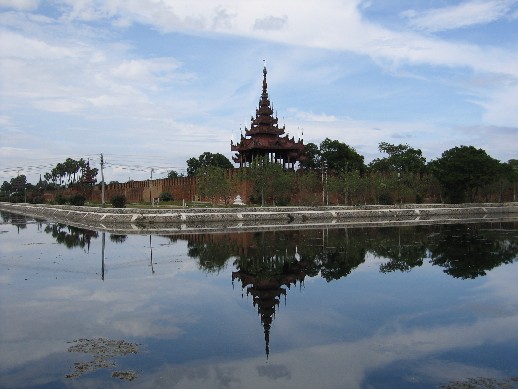
North of the city is Mandalay Hill which is capped with many gilded stupas and has a commanding view of the surrounding plains. The entrance to the hill is guarded by two enormous mythical lion/dragon beasts called ‘chinthes’. This creature seems to be the national symbol and appears on every piece of currency as well. There must be a thousand steps to the top of the hill via a long stairway lined with hawkers and your feet can take a bit of a beating since it must be done barefoot. Near the top of the hill is a statue commemorating a woman who cut off her breasts and offered them to the Buddha. “Thanks, but I’m vegetarian.” Along the way there are dozens of monks and other folks that want to practice their English with you including students wearing t-shirts that say ‘Speak English with Me’. The students needed to get your name to fill out their homework.
A view from Mandalay Hill back towards town.
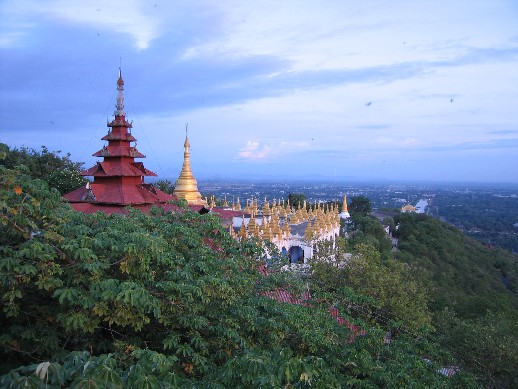
The key to the future: How to Speak English Well. Some of the phrases are classic.
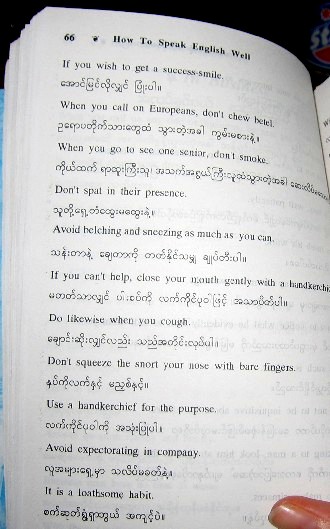
The national past time (for guys at least) is the game of ‘cane ball’ which is much like hacky-sack. The object is to keep the ball in the air by any means other than use of hands or arms. Some of these guys perform amazing acrobatic maneuvers to keep the ball in play. It is also played like volley ball with your feet over a net. The longyi can be folded into something akin to bulky shorts to make cane ball easier.
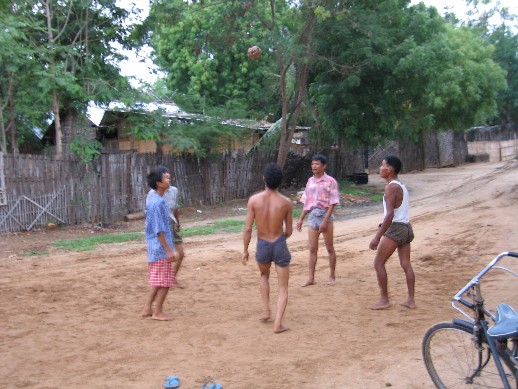
We left Mandalay for other parts of Myanmar but returned for our last 4 days in the country. We took a couple day trips from the town to a pair of the old Burmese capitols. The old city of Amarapura really wasn’t that exciting, but it is located around a large lake that is spanned by the scenic wooden U Bein bridge.
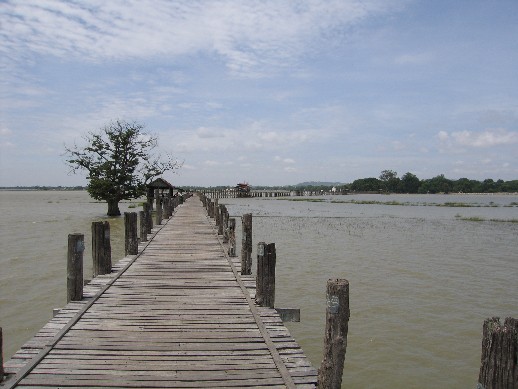
The other old capitol we visited was Mingun which is reached by a pleasant hour-long boat ride up the Ayeyarwady river. The river is full of locals going about their daily lives in home made boats. It is also home to a species of fresh-water dolphin, but they were shy that day.
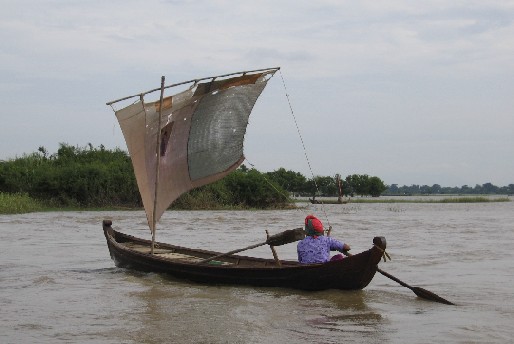
The town of Mingun is dominated by an enormous pile of bricks. The Mingun Paya was supposed to be the largest zedi in the world, but the king who ordered its construction died before it was even halfway complete. Note the people in the picture for scale – Kelly is the bright blue speck in the middle and there are people climbing up on the right.
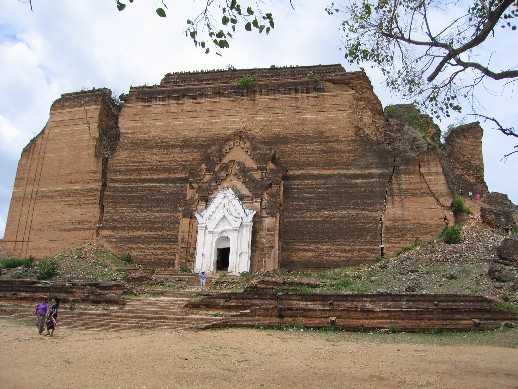
The same king also had the worlds largest (uncracked) bell forged and hung here. It’s about 5 meters in diameter and weighs about 90 tons. You can climb inside, but there is no way to really give it a good whack to hear it ring. You’d need a half dozen big men and a battering ram to ring this bell well.
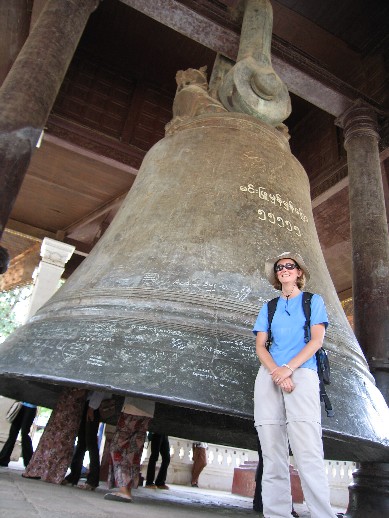
I scream, you scream…
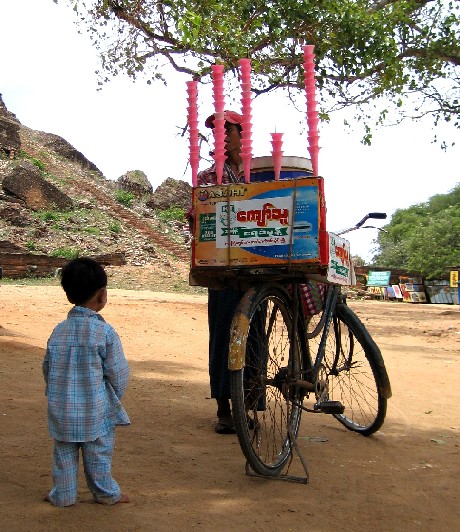
We went to show by the Moustache Brothers, which was a very good performance of comedy and dancing. One of the brothers was arrested in 1996 for a joke he told. The generals didn’t like the joke, and gave him seven years hard labor. They are only allowed to perform in their home where their electricity is frequently cut off by the goverment (they have backup generators which are used during performances). Only a few of their jokes involved politics. That said, they (half) joked that their father was sitting out in front of the home watching for military intelligence. The emergency exit was out the back door; they would run out the back if the government came (so they could escape and be back to perform the next night) while the tourists would run out the front and get arrested.

Tags: Myanmar

August 30th, 2005 at 6:17 am
Great information – what an interesting country!
Glad the generals left you two alone….
Hugs xoxox
August 30th, 2005 at 3:54 pm
I like the Moustache Brothers especially! Looks like fun.